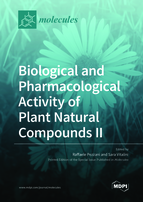Biological and Pharmacological Activity of Plant Natural Compounds II
A special issue of Molecules (ISSN 1420-3049). This special issue belongs to the section "Natural Products Chemistry".
Deadline for manuscript submissions: closed (15 November 2021) | Viewed by 63083
Special Issue Editors
2. Associazione Italiana per la Ricerca Oncologica di Base, Padova, Italy
Interests: plant medicinal chemistry; phytotherapy research; oncology; preclinical research; endocrinology
Special Issues, Collections and Topics in MDPI journals
Interests: crop protection; plant diseases; bioactivity; phytochemistry; ethnopharmacology; natural products
Special Issues, Collections and Topics in MDPI journals
Special Issue Information
Dear Colleagues,
Plants contain a plethora of diverse biochemical compounds. They are molecules which are necessary for plant survival, but they can also have a different fate: helping in the fight against human diseases. For centuries, humanity has used plant natural extracts to cure the most varied disorders, including cardiac disfunction, neoplasia, diabetes, circulation problems, and many others. However, only in recent decades have these ethnotraditional, evidenced-based, folkloric, anecdotic uses been converted into a scientific tool, with a real pharmacological, pathophysiological, and rational background. Despite strong advances in medicine, numerous diseases remain without practical treatment or have to deal with heavy drug side effects. In this regard, any effort to improve human health is a new path to follow, and plant natural compounds represent an infinite reserve of molecules that can be explored. Undeniably, many therapeutic properties of plants are still to be discovered. This Special Issue is intended to substantially contribute to our knowledge on their curative properties.
The Special Issue aims to uncover novel unconventional, alternative, and original characteristics of plant-derived compounds with a distinctive emphasis on biological and pharmacological activities. Moreover, phytocomplex (chemical compounds derived in full from plants) synergic effects, as well as the effects of single molecules will be explored in preclinical models, including normal and cancer cells, animals, and human-derived samples. Reviews investigating plant product effects and/or describing the state-of-the-art are welcome, considering the increasing role of plant-derived molecules in daily use.
Prof. Dr. Raffaele Pezzani
Prof. Dr. Sara Vitalini
Guest Editors
Manuscript Submission Information
Manuscripts should be submitted online at www.mdpi.com by registering and logging in to this website. Once you are registered, click here to go to the submission form. Manuscripts can be submitted until the deadline. All submissions that pass pre-check are peer-reviewed. Accepted papers will be published continuously in the journal (as soon as accepted) and will be listed together on the special issue website. Research articles, review articles as well as short communications are invited. For planned papers, a title and short abstract (about 100 words) can be sent to the Editorial Office for announcement on this website.
Submitted manuscripts should not have been published previously, nor be under consideration for publication elsewhere (except conference proceedings papers). All manuscripts are thoroughly refereed through a single-blind peer-review process. A guide for authors and other relevant information for submission of manuscripts is available on the Instructions for Authors page. Molecules is an international peer-reviewed open access semimonthly journal published by MDPI.
Please visit the Instructions for Authors page before submitting a manuscript. The Article Processing Charge (APC) for publication in this open access journal is 2700 CHF (Swiss Francs). Submitted papers should be well formatted and use good English. Authors may use MDPI's English editing service prior to publication or during author revisions.
Keywords
- Natural compounds
- Plant-derived products
- Plant natural products
- Biological and biochemical acitivity
- Pharmacological properties
- Plant pharmacology
- Phytotherapy
- Plant medicine
- Plant medicinal chemistry
- Phytocomplex effects
- Plant extracts and phytochemicals in preclinical models
- Phytotherapy and natural medicine








